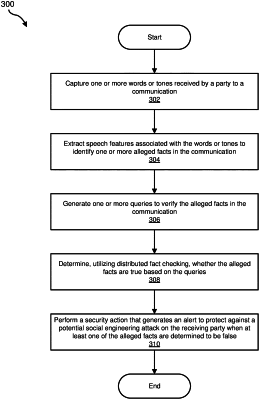| CPC H04L 63/1416 (2013.01) [G06F 16/9536 (2019.01); G06F 21/6245 (2013.01); G06F 40/279 (2020.01); H04L 63/1425 (2013.01)] | 20 Claims |

|
20. A non-transitory computer-readable medium comprising one or more computer-executable instructions that, when executed by at least one processor of a computing device, cause the computing device to:
capture one or more words or tones received by a receiving party to a communication;
extract speech features associated with the words or tones to identify one or more alleged facts in the communication;
generate one or more queries to verify the one or more alleged facts in the communication, wherein the one or more queries are generated by:
receiving a semantic triple from natural language processing performed on the one or more alleged facts in the communication, the semantic triple representing only text corresponding to a subject, an object, and an action from at least one of a statement and a claim made to the receiving party in the communication;
generating, in response to the semantic triple and based on results of the natural language processing, a partial question comprising a validation data field for receiving additional information to complete the partial question and to verify at least one of the subject and the object in the semantic triple that is associated with the one or more alleged facts, wherein the additional information for the validation data field comprises identification data, retrieved from the computing device, for verifying an alleged identity of the subject in the semantic triple associated with the one or more alleged facts; and
retrieving the identification data for the validation data field to complete the partial question as the one or more queries, wherein the identification data is utilized to verify the alleged identity of the subject;
determine, utilizing the distributed fact checking, whether the one or more alleged facts are true based on the one or more queries; and
perform a security action that generates an alert to protect against a potential social engineering attack on the receiving party when at least one of the one or more alleged facts are determined to be false.
|